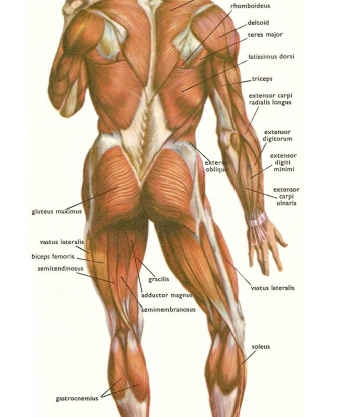Scientists and doctors refers to parts of their body in relation to each other:
- Anterior – front (stomach is anterior to spine)
- Posterior – back (spine is posterior to stomach)
- Medial – closer to the middle (nose is medial to ears)
- Lateral – farther from the middle (arms are lateral to spinal column)
- Superior – above (head is superior to chest)
- Inferior – below (feet are inferior to knees)
The term “posterior chain” refers to the group of muscles that start in the upper back, through the lower back, glutes, hamstrings, and calves.

Running, turning, braking, twisting, jumping, landing, passing, and shooting all involve a series of stretches and contractions of the muscles of the hips, legs, and ankles.
Soccer players are susceptible to injuries in the lower limbs (legs) (between 77% and 93% of all injuries) with hamstring injuries accounting for the largest percentage of muscular injuries (40%) followed by quadriceps (thigh), calves, and hips. Injuries to the ankle and knee joints are also significant risks (Barça Innovation Hub, 2019).
An imbalance between the anterior muscles (core, thigh, hips) and the posterior (glutes, hamstring, calves) can result in soft tissue injuries (muscle, ligament, or tendon tears).
Note the position and actions of the yellow player: stretching of the left quad and absorption of force in the left hamstring with concurrent contraction of the right hamstring and stretching of the right quadricep and hip flexor in the act of shooting. Research indicates that the hamstring is most susceptible to injury during the transition from extension (straightening) to contraction (Turner et al., 2014).

Developing strength in the hamstrings during extension (“eccentric strength training”) is an important component in injury prevention. The Nordic hamstring curl is a commonly used strengthening exercise (Turner et al., 2014).

Additional posterior chain strengthening activities include the glute bridge (Werking, 2019) and calf raise (Welsh Athletics, 2017):


Flexibility of the posterior chain muscles is also necessary to avoid injury. In addition to strengthening exercises, a continuing routine involving stretching of the anterior and posterior muscles and a pre-activity warmup have been observed to aid in improving and maintaining muscular flexibility (Turner et al., 2014).
References
Altis. (2019). Altis Foundations.
Barça Innovation Hub. (2019). Injury Prevention.
Behnke, R. S. (2012). Kinetic anatomy. Human Kinetics.
Crawley, M. (2014). Categorizing core training and its importance to programming. Personal Trainer Quarterly 1.2.
Schniederjan, S. (2013). Posterior Chain Linked: Don’t Lift Without It (Simple Strength Book 6) . Strength Productions LLC. Kindle Edition.
Turner, A. N., Cree, J., Comfort, P., Jones, L., Chavda, S., Bishop, C., & Reynolds, A. (2014). Hamstring strain prevention in elite soccer players. Strength & Conditioning Journal, 36(5), 10-20.
Werking, J. (2019). Bridging the gap between personal training and physical therapy. Personal Training Quarterly 6.1.
Welsh Athletics. (2017). Physical preparation. Welsh Athletics Coaching Resource